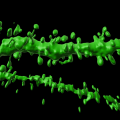Conference discusses animals as environmental monitors
Federal Minister for the Environment and Heritage Senator Robert Hill will address the first international conference on Sensory Processing of the Aquatic Environment at Heron Island, on the Great Barrier Reef, this week.
The University of Queensland and the University of Western Australia are jointly organising the conference, to be held from March 22 to March 28.
Conference co-organiser Dr Justin Marshall of the University of Queensland's Vision, Touch and Hearing Research Centre said 85 delegates from 12 countries, all world leaders in their fields, would attend.
"Sensory processing, the way other animals see, hear, smell, taste, feel, electrically and magnetically sense their environment, is not generally regarded as environmental science," he said.
"However, whenever man perturbs or alters the environment, it is the sense organs of animals which are the first line of contact. They see turbid waters, hear noise and vibration pollution, taste and smell chemical discharges and react accordingly.
"The variety and sensitivity of animal sensors is also much greater than humans, so animals can effectively monitor many different environments that are inaccessible or imperceptible to us.
"The fact that these other sensory channels exist makes it all the more important and valuable to study the relationship between the animal in question and its environment. If we ignore other sensory systems we run the risk of having a narrow, human-based definition which may lead to disaster.
"We can learn much about environmental issues and must temper our environmental program on this planet by examining sensory biology."
Fellow co-organiser Dr Shaun Collin, of the University of Western Australia's Zoology Department, said areas to be discussed included:
o Noise and vibrational pollution of the marine environment as the sounds of all frequencies carried well in aquatic environments. Scientists recently highlighted this issue in whale and other large marine mammal communities but it was of equal concern for fish and other aquatic organisms, many of which used sound for communication.
o Oil companies, commercial fisheries and other aquatic industries (ecotourism) were aware of the potential hazards of noise pollution. He said sensory biologists were able to identify sensitivity levels of aquatic vertebrates to such disturbances so that informed decisions could be made about developing new technologies. It was thought that many larval fish species used auditory cues to settle on coral reefs. Sensory information would undoubtedly be important to monitor and even alter plans to modify the underwater substrate contour (dredging of shipping channels) and for sinking of marine vessels.
o Many aquatic animals used electroreception for detection and communication, a sense unknown to humans but common in sharks, rays a variety of freshwater fish and Australia's duck-billed platypus. Increased nutrient and electrolyte load of rivers would drastically effect the platypus's ability to feed by increasing the conductivity of the water and thereby reducing the size of the electrical signals from prey. These effects could drive the platypus to more restricted areas and could explain its disappearance from the Western drainage of the Great Dividing range this century.
o Magnetic sense, although known for some time, had only this year been understood for the first time. Many aquatic organisms, such as migratory fish or turtles, used this ability, again completely foreign to humans, to find their way and navigate to breeding grounds. Until this remarkable sense was understood more fully, scientists did not know what curbs to place on man's interaction with the environment so as not to interfere with these processes.
o As shown recently by the massive bleaching event on the Great Barrier Reef, the quality of water on the reef was vital for its survival. The relative effects of increased UV, increased temperature and increased silt load in this event were still being debated. The bleaching phenomenon was of particular interest to visual scientists who spent significant time examining visual adaptations to different waters with different light environments. There would be more experts in this area at the conference than ever gathered in Australia.
o Because humans were primarily visual animals they tended to forget that many animals, especially those in aquatic environments, used smell and taste to navigate, find food and mates and even in defence. Discharge into seas and rivers had an enormous and largely unmonitored impact on the biology of these animals, Dr Collin said.
Media: For further information, contact Dr Marshall or Dr Collin, c/- the University's Heron Island Research Station, telephone 074978 1399, email: j.marshall@vthrc.uq.edu.au
.jpg)



